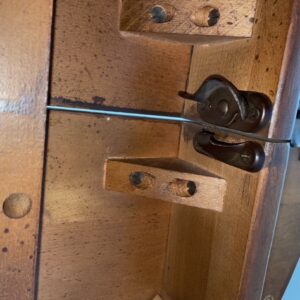greetings, and apologies for the baby question.
re: finishing, I’m on the flat part of the learning curve, the part to the left of where the steep part of the learning curve begins.
My sister told me yesterday that she’s refinishing a dining table from a beloved aunt and is thinking on sanding. I told her be careful if it’s veneer, you’ll sand through it and that won’t be good. Now she thinks I know what I’m talking about. So I need to perpetuate this.
This doesn’t look like veneer to me (well the top does, but the edge doesn’t). If I had to do it now without further research, I’d probably trying getting the old finish off with some type of solvent, then go with 3 progressive-grit rounds of sanding (assuming I don’t discover veneer), then apply the new finish.
If you could confirm/deny/correct the basic approach and offer any other feedback, I would appreciate it!
Thanks.
Neal


















Replies
I don't think it's veneer. A picture of the end of the boards, rather than the long edge, would help confirm this.
maybe I haven't looked closely enough but I thought the first pic was the long edge and the second pic was the short edge (end grain). Third pic is from the underside.
It's hard to tell on that second picture, since it's from below. If, from above, it shows a molding attached to the end of the leaf, it's probably hiding veneer, or plywood. An angle from above would be better.
If you find the same wood on the underside of the table it is solid and not veneer.
I would clarify this, being the same wood is not enough to confirm solid wood, think of a sheet of maple plywood, but it also needs to have consistent grain figure. Unfortunately this easier to see in prominent grain woods such as oak vs what appears to be maple.
Looks like solid wood to me. I like the window sash lock retrofit.
“[Deleted]”
Looking at the photos again...it looks like we have 2 tables? One is a dropleaf and the other a center-split.
I asked her to send a pic of whole table. This just in...(sorry about orientation).
She said “The surface isn’t marred too much but it has an underlying blemish problem, like eczema.” (Pic2)
Almost certainly solid wood.
I'd say solid wood. Your plan sounds like a good one. Start sanding a grit or two higher than you normally would; that's already a finished surface. You can always go lower if you need to.
thanks MJ. Can you recommend a solvent? I know with solvents there's a continuum in terms of strength, I just don't know where along that continuum we should be.
If I was doing that, I would refinish the top, and leave the legs and skirt with just a cleaning. I can't tell from the pics if that is sufficient.
If I was doing just the top I would skip solvent and sand. Start at 120 and see if that gets the finish off ok. I try to avoid solvents if I can.
perfect, thank you John.
Start with something mild and non toxic like Soy Gel.
I tend to agree that it is solid, but that is just an impression from the photos. If the table has a label or stamp on the underside indicating the maker, you might be able to contact them and ask.
You might try removing some hardware on the bottom and look closely around the top of the screw holes. You might be able to see if there is veneer there. If there is veneer on the bottom, there is also veneer on top.
Otherwise, just go slow. Sand only by hand; no machine. Try to sand an even amount everywhere. Be very careful on the edges; you will sand through more quickly there. If you are going to apply just a new clear finish (no stain), you don't necessarily need to get too far into bare wood. Sand only to the point where you have gone through the existing finish and no more. This way, if you do have veneer (surprise!) you won't risk going through it so much.
This forum post is now archived. Commenting has been disabled